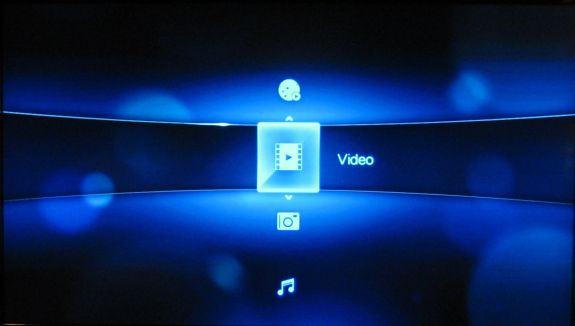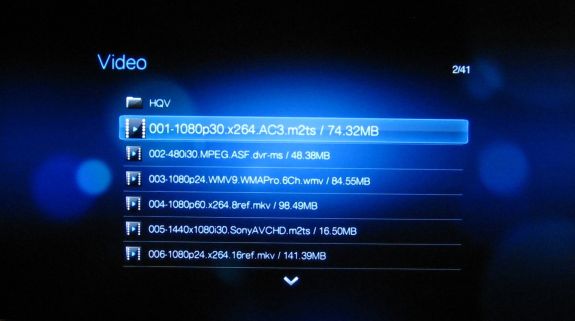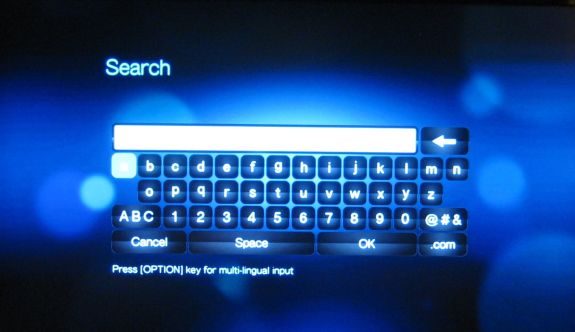WD TV Live Plus: Western Digital's Latest Media Player Reviewed
by Cameron Butterfield on July 29, 2010 1:00 AM EST- Posted in
- Home Theater
- Media Streamer
- WD
- WD TV Live Plus
The WD TV Live Plus is easy to setup, especially if you are utilizing the HDMI port that is capable of carrying all your audio and video signals at once over a single cable. Getting the WD TV Live Plus to lay flat after plugging in a heavy duty cable can be a bit of a challenge, as the weight and tension of the cable seems to make it flip to the side until you play with it for a while, but you can hardly blame WD for making such a slim and light device. However If you do purchase this device, you may want to invest in a roll of velcro or double sided tape to keep it in place.
Once seated and connected, the WD TV boots up quickly and you are provided with dark and light blue color scheme menu system that is very easily controled by using the arrow keys and a back, forward (OK) control scheme that is very reminiscent to the PSP, or PS3 menu system or Windows 7 Media Center. Western Digital did a good job of making the UI on this device familiar and easy to use for end users, they also have provided a screensaver mode that automatically blanks the screen and displays a WD logo in random areas.

When a USB device containing compatible media files is first inserted, the media library compilation process begins (if it is enabled), and media is sorted out into their respective media categories, namely Music, Video, or Photo. This feature allows you to use the search functionality rather than simply browsing around inside folders to find your media. In addition, the WD TV Live’s menu system provides file organization features as well, allowing you to move and copy your media and folders around on your connected storage devices. These are welcome features and gives the WD TV somewhat of a unique advantage over other media players that do not have these types of organizational features.
You can browse each of the sections (Video, Pictures and Music) using different viewing modes; thumbnails or list. The thumbnail view will show images for folders that have a FOLDER.JPG file within the folder, MP3 files with embedded artwork, photo files themselves, and mp4 files with user generated thumbnail images. This viewing mode works well for Music and Photos, but can be a troublesome viewing mode for videos. Since most videos do not have embedded images, the end result of viewing a folder full of videos is that you are unable to distinguish the videos from each other very easily, and when scrolling through the list of videos, the default thumbnail image is the same which creates a static visual effect where you can’t tell if you are actually scrolling through the video files or not. Sticking to the list or preview view on the video menu is recommended unless you are only viewing mp4 files that you have already generated the thumbnails for.


Western Digital also deserves some recognition for their efforts in providing a comprehensive manual for the WD TV Live Plus product. I was impressed with the level of detail and instruction on how to perform tasks on the device. Each step was outlined clearly with not only instructions but also many screenshots outlining each step and showing the action taking place on screen. This attention to detail makes a big difference in the user’s learning curve as it is much easier to translate screenshots into actual device usage rather than just text on a blank white page.










81 Comments
View All Comments
adamsteinberg - Saturday, July 31, 2010 - link
I'd like to see which files you actually used -- it'd be good to have as a reference for the rest of us.ganeshts - Sunday, August 1, 2010 - link
Most of the streams in the test suite are available with a search on Google (such as the infamous bird scene clip from Planet Earth / NMT DVD5 Test Disc contents) . Some of them are copyrighted, and can't be made publicly available.Instead of releasing files selectively, we think it would be better to avoid releasing the any part of the suite to the public. That said, media streamer vendors can and do get access to the files if they find that their units are unable to playback a particular stream in our review process.
jmunjr - Monday, August 2, 2010 - link
Did they improve on the WD Live's lousy network support? There was no cataloging of media via the network, only on loccal drives connected to USB. What's the point of network support if finding media requires manually navigating the network shares? STUPID.Also playing any music off the network is pointless as well as you have to manually navigate and it is impossible to even shuffle music effectively without putting it all into one folder with no subfolders. STUPID.
SlyNine - Monday, August 2, 2010 - link
As I said in my post. I agree and this is important for people trying to serve multiple rooms. Or people that are not computer illiterate.Jmunjr, I would try out twonky. It makes things alot easier.
jmunjr - Tuesday, August 3, 2010 - link
Sorry if I missed that part of the article.Twonky looks promising. Thanks.
SlyNine - Monday, August 2, 2010 - link
I bought the WDLive for the living room. I bought Twonky to make it easier to use. The most important thing is ease of use if I'm going to deploy them threw out the house. I don't want people bugging me about how to use it.Really it all comes down to being able to map network shares and have the player build a library. So the next person only has a simple menu, Video, Music.
So if you could take the to talk about ease of use, I'd really appreciate that.
Also any media server recommendations would be great.
ProDigit - Monday, August 2, 2010 - link
Hah!The thing I had hoped to see was a built in TV decoder, and it does not even have it!
Why even bother with the 'TV' in the product's name, when the only thing it can do is connect to LCD or Plasma screens via HDMI?
I mean, if it really was a TV media box, the least it should have had was a TV and radio tuner (both digital and analog) to make it somewhat interesting!
So far it seems nothing more than a harddrive with a low quality graphics card attached to it...
I'm happy they invent things like this, but that's not fully what the average customer needs!
Especially not when LCD's are becoming cheap, and you can buy a 28" LCD screen for under 300, and connect it to a TV tuner AND a pc at the same time.
In other words as a media player it succeeds, but not to replace a home theater!
People living in studio's would really want this TV decoder function added to the HD playback ability of this device, in ONE device.
One thing that's bothering me the most is the amount of remotes that are on an average livingroom table. One for the TV, one for the VCR, one for the DVD, one for the blueray, and one for the sattelite or cable signal decoder.
They could have made all this in one device, leaving you with one USB port for the blueray drive to watch blueray or DVD videos, one remote for the LCD and one for this device.
Modelworks - Sunday, August 8, 2010 - link
The WD boxes and most others use a chipset originally designed for DVR , IPTV, and set top boxes for cable and satellite service. When they were designed they were designed with specific codecs and industry standards. Do not expect them to play every combination of video that exist because the ones that will not play on the box are not following the specification. One thing that a pc allows users to do is update codecs. Often those updates are not to fix problems in the codec but to allow the codec to play content that has been encoded using options that are not part of the specification. People like to try pushing codecs and often that leads to files not playing except for those that have the same version codec as the encoder.If you like to play with codec settings and use files that do then a pc is the only option. If you stick to established specifications then the sigma based players are as good as anything.
De-interlacing is not a strong part of the sigma chipsets and little attention is given to it in the sdk. Part of the reason for this is it was designed with playing back content that is already de-interlaced. Only Mpeg2 is given some real attention and the file has to be in the DVD specified format .
If WMAPRO is important for you , you can visit this site to get the custom firmware that adds support for it.
http://b-rad.cc/1249/wdlxtv-live-0-4-2-1/#more-124...
DTS/Dolby support varies with players. Just depends on if they wanted to play the licensing fees or not . All the current sigma chipset can decode the format fine.
IcetomLT - Wednesday, August 18, 2010 - link
Very good review!. I think now Anandtech developed best testing for media players!Just one ask - is it possible to include HQV PAL 1.4a DVD tests (for SD signal). Because, now your HQV test shows only player's performance for NTSC type signal in HD resolution and doesn't show how good upscaling engine is used in player and if it supports PAL cadences.
kojak40 - Tuesday, April 15, 2014 - link
I have a question. Can I see the attached storage connected the the we live TV box on my computer. I want to be able to send files to the hard drive from my computer and or android phone. If I can't do that it's a deal breaker for me.